William Crowther (Australian politician) facts for kids
Quick facts for kids
Dr
William Crowther
FRCS
|
|
|---|---|
 |
|
| 14th Premier of Tasmania | |
| In office 20 December 1878 – 29 October 1879 |
|
| Preceded by | William Giblin |
| Succeeded by | William Giblin |
| Personal details | |
| Born |
William Lodewyk Crowther
15 April 1817 Haarlem, Netherlands |
| Died | 12 April 1885 (aged 67) Hobart, Tasmania, Australia |
| Spouse | Sarah Victoria Marie Louise Muller |
| Profession | Surgeon |
William Lodewyk Crowther (born April 15, 1817 – died April 12, 1885) was an important politician in Tasmania, Australia. He served as the leader of Tasmania, known as the Premier, from December 1878 to October 1879. He was also a skilled surgeon.
Contents
Early Life and Education
William Crowther was born in Haarlem, Netherlands, on April 15, 1817. His family moved to Van Diemen's Land (which is now called Tasmania) in 1824. His father was also a surgeon in Hobart.
William went to school at Richard B. Claiborne's Grammar School in Longford, Tasmania. He often walked long distances to and from school during holidays. These walks helped him become very interested in nature and animals.
Becoming a Surgeon
After school, William started training to be a pharmacist in Hobart. When his father passed away in 1839, William decided to continue his medical studies in England.
To pay for his studies, he traveled from Hobart with a large collection of Tasmanian animals. This collection included small kangaroos called potoroos, wallabies, and even two Tasmanian devils. He also had nearly 500 animal skins. He sold this collection to a rich English Earl. This money helped him study at St Thomas's Hospital in London and for a year in Paris.
In 1842, William Crowther returned to Hobart. He took over his father's medical practice and became a well-known surgeon.
Business Ventures
Besides being a doctor, William Crowther was involved in many different businesses in Tasmania. He owned ships and sawmills located on the Huon River.
He used his ships to transport timber from Tasmania to other parts of Australia and to New Zealand. He also sent ships to collect guano (which is bird droppings used as fertilizer) from islands in the Coral Sea. He was also involved in sealing and whaling from Hobart.
Political Career
William Crowther became involved in politics in Tasmania. He was first elected to the Tasmanian House of Assembly in October 1866. However, he resigned from this position a few months later.
In March 1869, he was elected to the Tasmanian Legislative Council. He represented Hobart and stayed in this role until he died. He was known for attending meetings regularly and being a good speaker.
In July 1876, he joined the government led by Thomas Reibey. He became a minister without a specific department, meaning he helped with general government duties. On December 20, 1878, he became the Premier (the leader of the government).
However, the political situation at that time was very difficult. It was hard for him to make big changes. Because of these challenges, Crowther resigned as Premier on October 29, 1879.
Death and Legacy
William Crowther passed away in Hobart on April 12, 1885. He was almost 68 years old. He was survived by his wife, Victoria Marie Louise, and their eight children. One of his sons, Edward Crowther, also became a member of the Tasmanian parliament.
In 1935, a face mask of W. L. Crowther was placed in a special gallery in Canberra. This gallery honored important Australians.
The W. L. Crowther Library was named in his honor. His grandson, Sir William Crowther, gave this library to the State Library of Tasmania in 1964.
Crowther's Statue
A bronze statue of William Crowther was put up in Franklin Square, Hobart, on January 9, 1889. People donated money to build it. The words on the statue thanked him for his long service in politics and medicine in Tasmania.
In August 2022, the Hobart City Council voted to remove Crowther's statue from public display. This decision was made as an act of reconciliation. The Lord Mayor of Hobart, Anna Reynolds, explained that removing the statue does not change history. Instead, it shows that the city does not want to celebrate a time when some scientists believed in theories of European superiority. The council planned to keep the statue safe and discuss moving it to the Tasmanian Museum and Art Gallery.
In May 2024, the statue was damaged and toppled. This act was condemned as vandalism by the Hobart City Council. Graffiti was sprayed on the base. The Tasmanian Aboriginal Centre said that the damage reflected how many people in the community felt the statue should be removed. This incident happened after an earlier attempt to cut the statue's legs.


